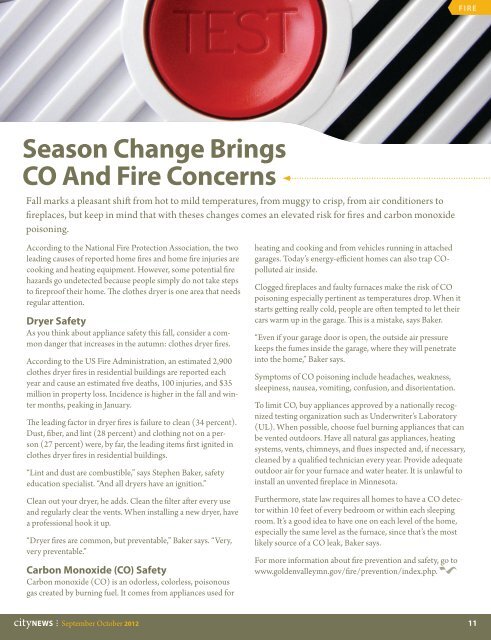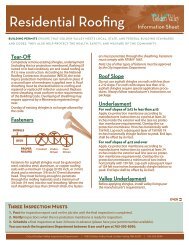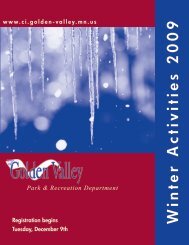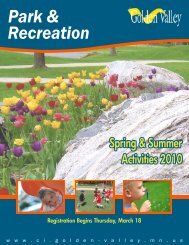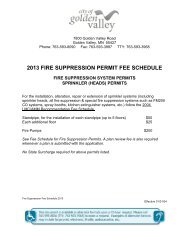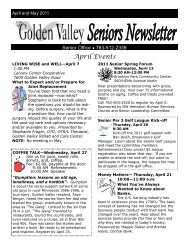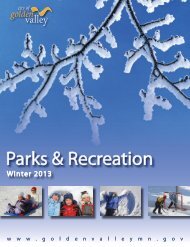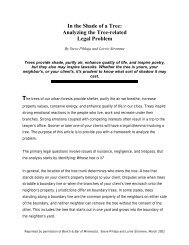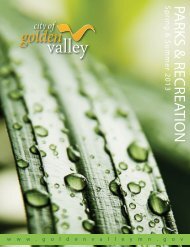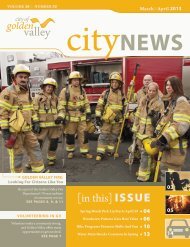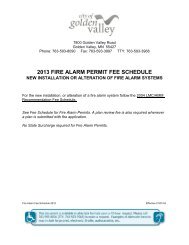September/October 2012 - City of Golden Valley
September/October 2012 - City of Golden Valley
September/October 2012 - City of Golden Valley
Create successful ePaper yourself
Turn your PDF publications into a flip-book with our unique Google optimized e-Paper software.
FIRE<br />
Season Change Brings<br />
CO And Fire Concerns<br />
Fall marks a pleasant shift from hot to mild temperatures, from muggy to crisp, from air conditioners to<br />
fireplaces, but keep in mind that with theses changes comes an elevated risk for fires and carbon monoxide<br />
poisoning.<br />
According to the National Fire Protection Association, the two<br />
leading causes <strong>of</strong> reported home fires and home fire injuries are<br />
cooking and heating equipment. However, some potential fire<br />
hazards go undetected because people simply do not take steps<br />
to firepro<strong>of</strong> their home. The clothes dryer is one area that needs<br />
regular attention.<br />
Dryer Safety<br />
As you think about appliance safety this fall, consider a common<br />
danger that increases in the autumn: clothes dryer fires.<br />
According to the US Fire Administration, an estimated 2,900<br />
clothes dryer fires in residential buildings are reported each<br />
year and cause an estimated five deaths, 100 injuries, and $35<br />
million in property loss. Incidence is higher in the fall and winter<br />
months, peaking in January.<br />
The leading factor in dryer fires is failure to clean (34 percent).<br />
Dust, fiber, and lint (28 percent) and clothing not on a person<br />
(27 percent) were, by far, the leading items first ignited in<br />
clothes dryer fires in residential buildings.<br />
“Lint and dust are combustible,” says Stephen Baker, safety<br />
education specialist. “And all dryers have an ignition.”<br />
Clean out your dryer, he adds. Clean the filter after every use<br />
and regularly clear the vents. When installing a new dryer, have<br />
a pr<strong>of</strong>essional hook it up.<br />
“Dryer fires are common, but preventable,” Baker says. “Very,<br />
very preventable.”<br />
Carbon Monoxide (CO) Safety<br />
Carbon monoxide (CO) is an odorless, colorless, poisonous<br />
gas created by burning fuel. It comes from appliances used for<br />
heating and cooking and from vehicles running in attached<br />
garages. Today’s energy-efficient homes can also trap COpolluted<br />
air inside.<br />
Clogged fireplaces and faulty furnaces make the risk <strong>of</strong> CO<br />
poisoning especially pertinent as temperatures drop. When it<br />
starts getting really cold, people are <strong>of</strong>ten tempted to let their<br />
cars warm up in the garage. This is a mistake, says Baker.<br />
“Even if your garage door is open, the outside air pressure<br />
keeps the fumes inside the garage, where they will penetrate<br />
into the home,” Baker says.<br />
Symptoms <strong>of</strong> CO poisoning include headaches, weakness,<br />
sleepiness, nausea, vomiting, confusion, and disorientation.<br />
To limit CO, buy appliances approved by a nationally recognized<br />
testing organization such as Underwriter’s Laboratory<br />
(UL). When possible, choose fuel burning appliances that can<br />
be vented outdoors. Have all natural gas appliances, heating<br />
systems, vents, chimneys, and flues inspected and, if necessary,<br />
cleaned by a qualified technician every year. Provide adequate<br />
outdoor air for your furnace and water heater. It is unlawful to<br />
install an unvented fireplace in Minnesota.<br />
Furthermore, state law requires all homes to have a CO detector<br />
within 10 feet <strong>of</strong> every bedroom or within each sleeping<br />
room. It’s a good idea to have one on each level <strong>of</strong> the home,<br />
especially the same level as the furnace, since that’s the most<br />
likely source <strong>of</strong> a CO leak, Baker says.<br />
For more information about fire prevention and safety, go to<br />
www.goldenvalleymn.gov/fire/prevention/index.php.<br />
• <strong>September</strong> <strong>October</strong> <strong>2012</strong> 11


